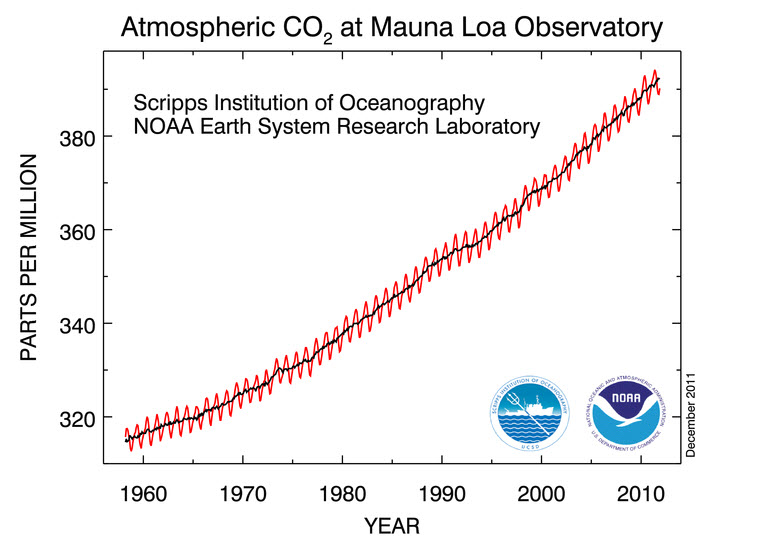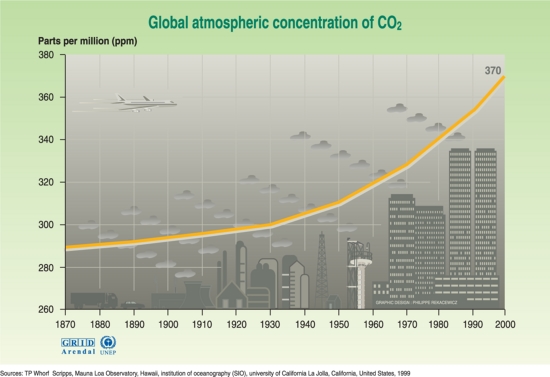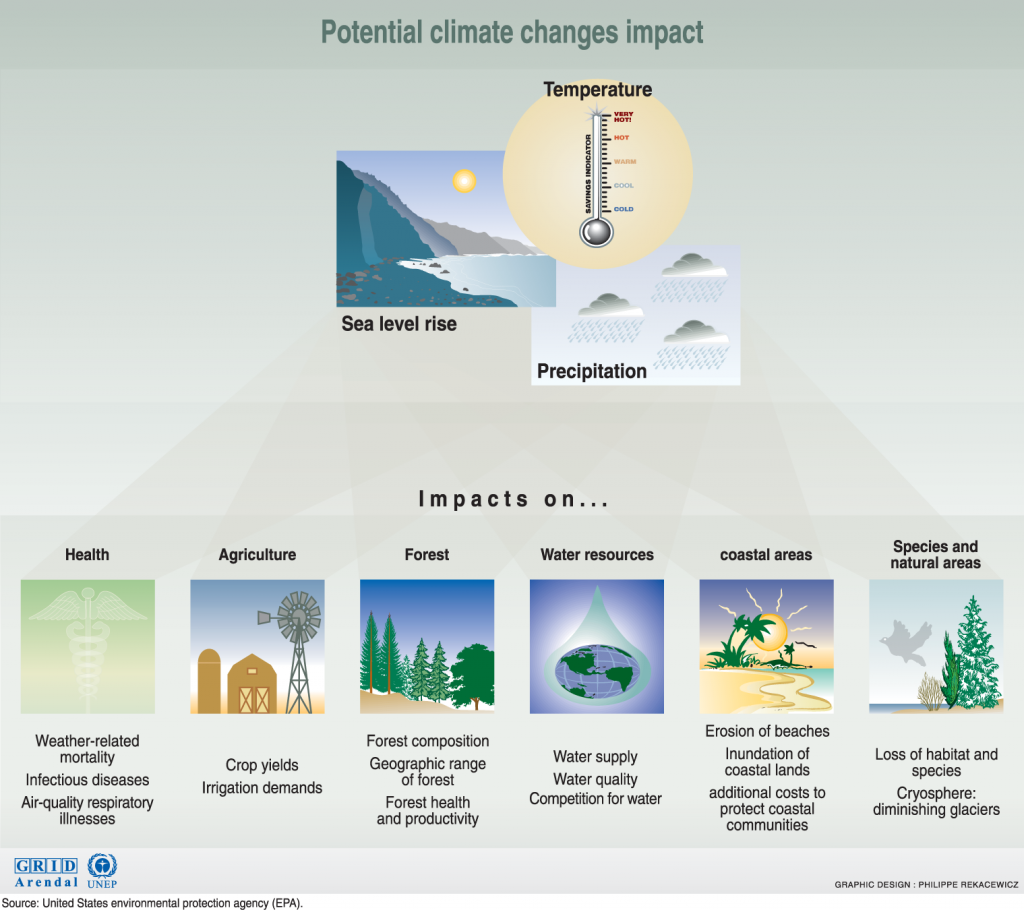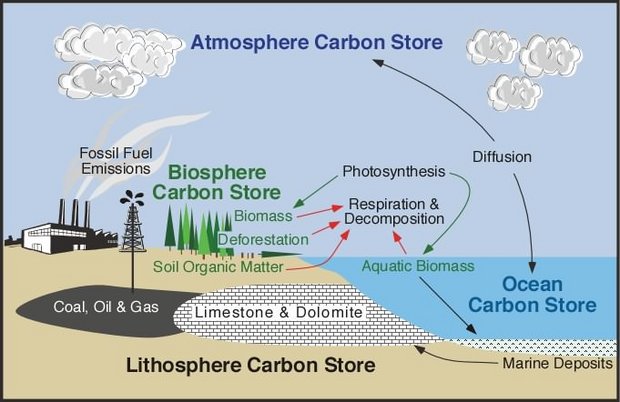Climate Literacy: The Essential Principles of Climate Sciences summarizes the most important principles and concepts of climate science. It presents information that individuals and communities need to understand Earth’s climate, impacts of climate change, and approaches for adapting and mitigating change. This article provides background science-content knowledge for understanding Essential Principle 6: Human activities are impacting the climate system, which describes the causes and effects of human-induced climate change.
Essential Principle 6 describes how greenhouse gas emissions and large changes in land cover, which have widespread impacts throughout the Earth system, are linked to a warming climate. The potential for human activities to increase the temperature of the Earth through greenhouse gas emissions has been described and calculated for over a century. Volumes of scientific research across multiple scientific disciplines now support this principle. The Intergovernmental Panel on Climate Change (IPCC ) Fourth Assessment Report states, “There is very high confidence that the net effect of human activities since 1750 has been one of warming” (IPCC, 2007).
Principle 6 also describes how, due to basic physics of heat-trapping gases and exponential rise in population and energy consumption, humans have become a force of nature. This is a complex topic with enormous political, socio-economic and emotional dimensions, but the scientific results show clearly that:
- Human activities, particularly the combustion of fossil fuels, are altering the climate system.
- Human-driven changes in land use and land cover, such as deforestation, urbanization, and shifts in vegetation patterns, also alter the climate, resulting in changes to the reflectivity of the Earth surface (albedo), emissions from burning forests, urban heat island effects and changes in the natural water cycle.
- Because the primary cause of recent global climate change is human, the solutions are also within the human domain.
- Transparency about the causes of climate change allows for effective solutions to be developed and deployed (Climate Literacy & Energy Awareness Network, 2010).
The following concepts are fundamental to understanding Principle 6. You can click on a concept to find the background knowledge to help you understand the concept.
Note: For additional ideas and resources for teaching each of the Essential Principles of Climate Sciences go to the Climate Literacy & Energy Awareness Network. Another good introduction to the seven essential principles is Earth: The Operator’s Manual, an hour-long film shown on PBS and based on the book of the same name by Richard Alley. The entire film is available but the site also provides short segments for teachers to preview and download (free, simple registration required), both with closed captioning for ESL and science comprehension support. A video from the U.S. Environmental Protection Agency (EPA), Climate 101 (second row, middle) explores what climate change is, signs or indicators that the planet is warming, and why it matters. Watch the video to learn more about the causes and effects of climate change and practical solutions to reduce carbon dioxide and other greenhouse gas emissions. An excellent rebuttal of climate change skeptics can be found in Why the Global Warming Skeptics Are Wrong (published 2/22/2012).
Concept A.The overwhelming consensus of scientific studies on climate indicates that most of the observed increase in global average temperatures since the latter part of the 20th century is very likely due to human activities, primarily from increases in greenhouse gas concentrations resulting from the burning of fossil fuels.
Concept B. Emissions from the widespread burning of fossil fuels since the start of the Industrial Revolution have increased the concentration of greenhouse gases in the atmosphere. Because these gases can remain in the atmosphere for hundreds of years before being removed by natural processes, their warming influence is projected to persist into the next century.
Concept C. Human activities have affected the land, oceans, and atmosphere, and these changes have altered global climate patterns. Burning fossil fuels, releasing chemicals into the atmosphere, reducing the amount of forest cover, and rapid expansion of farming, development, and industrial activities are releasing carbon dioxide into the atmosphere and changing the balance of the climate system.
Concept D. Growing evidence shows that changes in many physical and biological systems are linked to human-caused global warming. Some changes resulting from human activities have decreased the capacity of the environment to support various species and have substantially reduced ecosystem biodiversity and ecological resilience.
Concept E. Scientists and economists predict that there will be both positive and negative impacts from global climate change. If warming exceeds 2 to 3°C (3.6 to 5.4°F) over the next century, the consequences of the negative impacts are likely to be much greater than the consequences of the positive impacts.
You can also see where these concepts are found in national standards documents as well as find common misconceptions in the Standards and Curriculum Connections article.
Concept A. The overwhelming consensus of scientific studies on climate indicates that most of the observed increase in global average temperatures since the latter part of the 20th century is very likely due to human activities, primarily from increases in greenhouse gas concentrations resulting from the burning of fossil fuels.
There is substantial evidence that human activities, especially burning fossil fuels, are leading to increased levels of carbon dioxide and other greenhouse gases in the atmosphere, which in turn amplify the natural greenhouse effect, causing the temperature of the Earth’s atmosphere, ocean and land surface to increase. That greenhouse gases do “trap” infrared heat is well established through laboratory experiments going back to the mid-1850s when Sir John Tyndall first measured the effect. To learn more about how scientists study climate change, read the science content-knowledge article Earth’s Changing Climate: How Do We Know What We Know?.
So what exactly are greenhouse gases and how do they work? Some of the gases in our atmosphere, such as carbon dioxide, methane, and even water vapor, have the ability to trap or block the transmission of infrared light. Once the Sun’s energy reaches Earth, it is intercepted first by the atmosphere. A small part of the Sun’s energy is directly absorbed, particularly by certain gases such as water vapor. Some of the Sun’s energy is reflected back to space by clouds and the Earth’s surface.
Most of the radiation, however, is absorbed by Earth’s surface. When the radiation is absorbed by a substance, the atoms in the substance move faster and the substance becomes warm to the touch. The absorbed energy is transformed into heat energy. This heat energy plays an important role in regulating the temperature of Earth’s crust, surface waters, and lower atmosphere.
Without the greenhouse effect, infrared light leaving the Earth’s surface would escape into space, leaving the Earth much cooler than it is, particularly at night. The gases in our atmosphere prevent that from happening and trap the heat. An example of what happens when such concentrations are too high can be seen by looking at our planetary neighbor, Venus. Venus’s atmosphere is more than 96 percent carbon dioxide (compared to 0.038 percent on Earth), and the temperature can reach 460 degrees Celsius (890 degrees Fahrenheit). On the other hand, the planet Mars has a very thin atmosphere and is quite cold at minus 63 degrees Celsius (minus 81 degrees Fahrenheit).
So what is the relationship between greenhouse gases and fossil fuels? Fossil fuels are energy resources that come from the remains of plants and animals that lived hundreds of millions of years ago. When these organisms died, they were covered up by layers of mud, rock, sand, and in some cases water. Over the next many millions of years, the plants and animals decomposed into fossil fuels. The type of fuel the organisms became – oil, natural gas, or coal – depended on several factors: who they were buried with, how long they were buried, and what temperature and pressure existed while they were decomposing.
All plants convert carbon dioxide from the air into carbohydrates (biomass) and oxygen (released into the air) through the process of photosynthesis. When we burn firewood, ethanol, or coal, oil and other fossil fuels, oxygen in the air is consumed, and carbon dioxide is released back to the atmosphere. Thus, carbon dioxide that was removed from the atmosphere millions of years ago is being added back to the atmosphere through the consumption of these fuels. The burning of fossil fuels releases not only carbon dioxide but also hydrocarbons, nitrogen oxides, and other trace materials that pollute the atmosphere and can contribute to long-term health and environmental problems. As the rate of burning fossil fuels increases, so does the amount of carbon dioxide returned to the atmosphere, and in turn the amount of heat trapped. This graph visually shows the rapid increase of atmospheric carbon dioxide.

Atmospheric carbon dioxide levels at Mauna Loa Observatory, Hawaii. Graphic courtesy of NOAA Earth System Research Laboratory, Global Monitoring Division.
The carbon dioxide data (red curve), measured as the mole fraction in dry air, on Mauna Loa constitute the longest record of direct measurements of CO2 in the atmosphere. Data are reported as a dry mole fraction defined as the number of molecules of carbon dioxide divided by the number of molecules of dry air multiplied by one million (ppm).They were started by C. David Keeling of the Scripps Institution of Oceanography in March of 1958 at a facility of the National Oceanic and Atmospheric Administration. NOAA started its own CO2 measurements in May of 1974, and they have run in parallel with those made by Scripps since then. The black curve represents the seasonally corrected data (NOAA, 2005).
Related Resources
Enhanced Greenhouse Effect: A Hot International Topic
Without the greenhouse effect we would be living in a very chilly place – the world’s average temperature would be minus 19°C, instead of the 14°C we are used to. So what is the greenhouse effect and how does it make Earth around 33°C warmer?
Climate Kids: What Is the Greenhouse Effect?
In question-and-answer format with many illustrations, this site answers questions a student might have about the greenhouse effect. The site also includes questions scientists are trying to find answers to, all written in an easy-to-read style.
Greenhouse Effect Movie
In this movie, Professor Scott Denning of the Atmospheric Science Department at Colorado State University explains how greenhouse gases in Earth’s atmosphere warm our planet. Denning first explains how visible light (a form of electromagnetic radiation) from the Sun delivers energy to Earth. Next, he describes how some of this energy is trapped in Earth’s atmosphere by the greenhouse effect, which warms our planet. Molecules of greenhouse gases, especially water vapor and carbon dioxide, “recycle” some of the heat energy that would otherwise escape from Earth in the form of infrared radiation.
Concept B. Emissions from the widespread burning of fossil fuels since the start of the Industrial Revolution have increased the concentration of greenhouse gases in the atmosphere. Because these gases can remain in the atmosphere for hundreds of years before being removed by natural processes, their warming influence is projected to persist into the next century.
Concentrations of carbon dioxide in the atmosphere are naturally regulated by numerous processes collectively known as the carbon cycle. Carbon cycling involves many carbon-containing compounds and biological processes such as photosynthesis. On a longer time span, carbon dioxide is moved from the atmosphere and the ocean and into the ground through biologic and geologic processes. Some carbon is transformed into calcium carbonate (limestone), the largest carbon reservoir on Earth as shown in the following image. Carbon is reduced by the accumulation of seafloor sediments and the uptake of carbon by plants as they make carbohydrates.
Two processes that increase the abundance of carbon in the atmosphere are deforestation and the combustion of fossil fuels – basically the reverse of the two processes that decrease the amount of carbon in the atmosphere. Trees are natural consumers of carbon dioxide – one of the greenhouse gases whose buildup in the atmosphere contributes to global warming. Destruction of trees not only removes these “carbon sinks,” but tree burning and decomposition pump into the atmosphere even more carbon dioxide, along with methane, another major greenhouse gas. Burning any fossil fuel produces carbon dioxide, which contributes to the “greenhouse effect,” warming the Earth.
The burning of fossil fuels produces around 21.3 billion metric tons of carbon dioxide per year, but it is estimated that natural processes can only absorb about half of that amount, leading to a net increase of 10.65 billion metric tons of atmospheric carbon dioxide per year (U.S. Energy Information Administration, 2004). The Earth’s positive imbalance between emissions and absorption results in the continuing growth in greenhouse gases in the atmosphere.
The image below shows that the atmospheric CO2 has increased from a pre-industrial concentration of about 280 ppmv to about 367 ppmv in 2000 (ppmv= parts per million by volume). Carbon dioxide concentration data from before 1958 are from ice core measurements taken in Antarctica and from 1958 onwards are from the Mauna Loa measurement site. The smooth curve is based on a hundred year running mean. It is evident that the rapid increase in CO2 concentrations has been occurring since the onset of industrialization. The increase has closely followed the increase in CO2 emissions from fossil fuels.

Image courtesy of UNEP/GRID-Arendal. Data sources: TP Whorf Scripps, Mauna Loa Observatory, Hawaii, Institution of Oceanography (SIO), University of California La Jolla, California, United States, 1999.
Related Resources
Global Warming: It’s All About Carbon
A five-part series of humorous animated shorts that illustrate the central role that carbon plays in climate change. From NPR’s Climate Connections series.
Photosynthesis
This video segment from Interactive NOVA: Earth explores the history of plant biology. It takes the viewer from the earliest scientific hypotheses that plants ate dirt, to our present-day understanding of photosynthesis, the process by which plants use the sun’s energy to convert carbon dioxide and water into carbohydrates, a storable form of chemical energy.
Carbon Dioxide and the Greenhouse Effect
Human activities are causing increasing amounts of carbon dioxide to be pumped into the atmosphere. But is this increase resulting in global warming? This video segment adapted from NOVA/FRONTLINE demonstrates carbon dioxide’s role in the greenhouse effect and explains how increasing concentrations of this gas in the atmosphere may be contributing to global warming.
Concept C. Human activities have affected the land, oceans, and atmosphere, and these changes have altered global climate patterns. Burning fossil fuels, releasing chemicals into the atmosphere, reducing the amount of forest cover, and rapid expansion of farming, development, and industrial activities are releasing carbon dioxide into the atmosphere and changing the balance of the climate system.
Anthropogenic (human-induced) climate change refers to the production of greenhouse gases emitted by human activity. By examining the polar ice cores, scientists are convinced that human activity has increased the proportion of greenhouse gases in the atmosphere, which has skyrocketed over the past few hundred years. The Intergovernmental Panel on Climate Change (IPCC) Fourth Report released in 2007 stated that multiple lines of evidence confirm that the post-industrial rise in greenhouse gases does not stem from natural mechanisms (Intergovernmental Panel on Climate Change, 2007). In other words, this is anthropogenic climate change, and the significant increases in the atmosphere of these potent greenhouse gases are a result of human activity.
The IPCC Fourth Report confirms that over the past 8,000 years, and just before Industrialization in 1750, carbon dioxide concentration in the atmosphere increased by a mere 20 parts per million (ppm). The concentration of atmospheric CO2 in 1750 was 280ppm, and increased to 379 ppm in 2005. That is a increase of 100 ppm in 250 years. For comparison and at the end of the most recent ice age there was approximately an 80ppm rise in CO2 concentration. This rise took over 5,000 years, and higher values than at present have only occurred many millions of years ago.
As the global population grew from less than a billion people in the year 1700 to more than six billion in the year 2010, the planet’s vegetation cover, albedo and hydrologic processes have been substantially altered. While releasing carbon dioxide from these activities is a key concern, methane from agriculture and wetlands, Arctic permafrost, and overall alteration of land cover must also be considered.
Greenhouse gas concentrations continue to rise, which continues to impact climate. Those increases in the concentration of carbon dioxide will have wide-ranging effects on the environment and socio-economic and related sectors, such as health, agriculture, forests, water resources, coastal areas and biodiversity.

Potential climate change impacts. Graphic courtesy of Philippe Rekacewicz, UNEP/GRID-Arendal. Source: United States Environmental Protection agency (EPA).
Related Resources
Deforestation in Amazonia
This web site describes the impact of cutting down the Amazon rainforests.
Concept D. Growing evidence shows that changes in many physical and biological systems are linked to human caused global warming. Some changes resulting from human activities have decreased the capacity of the environment to support various species and have substantially reduced ecosystem biodiversity and ecological resilience.
The climate around the globe gives rise to a variety of ecosystems. Changes to climate affect organisms found in those ecosystems; organisms respond to climate changes by adapting or migrating. Species can also die out because they have only limited ability to adapt to environmental changes. Humans have a responsibility to stabilize the natural climatic conditions in order to preserve the environments in which humans and the surrounding ecosystems thrive.
Most plants and animals live in areas with very specific climate conditions, such as temperature and rainfall patterns. Any change in the climate of an area can affect the plants and animals living there, as well as the makeup of the entire ecosystem. Plants and animals have adapted to changes in the environment for millions of years. However, today’s changes are happening faster and on a larger scale than in the past, which makes it difficult for plants and animals to adapt. Some species are already responding to a warmer climate by moving to cooler locations. For example, some North American animals and plants are moving farther north or to higher elevations to find suitable places to live.
Climate change also alters the life cycles of plants and animals. For example, as temperatures get warmer, many plants are starting to grow and bloom earlier in the spring and survive longer into the fall. Some animals are waking from hibernation sooner or migrating at different times, too. Some unwelcome invaders (invasive species) could benefit from climate change by expanding their range or being able to survive through the winter in new places.
In the United States the Clean Air Act and the Clean Water Act have been used to monitor and regulate specific forms of pollution, helping to minimize the impacts of acid rain and severe water pollution from industrial and municipal sources. The Endangered Species Act is used to protect threatened populations and habitats to prevent extinction. The linkages between different Earth systems mean that many human activities can potentially impact climate and, indirectly, species.
Related Resources
Climate Change Wildlife & Wildlands Toolkit and Video
This resource divides the United States into 11 distinct “ecoregions” based on a number of factors, including geography and habit type. Each ecoregion includes a case study and activities that will bring alive the impacts and solutions to climate change. A 12-minute video on climate change science and impacts on wildlife and their habitat is also available.
Concept E. Scientists and economists predict that there will be both positive and negative impacts from global climate change. If warming exceeds 2 to 3°C (3.6 to 5.4°F) over the next century, the consequences of the negative impacts are likely to be much greater than the consequences of the positive impacts.
Many elements of human society and the environment are sensitive to climate variability and change. Human health, agriculture, natural ecosystems, coastal areas, and heating and cooling requirements are examples of climate-sensitive systems. Rising average temperatures are already affecting the environment. Some observed changes include shrinking of glaciers, thawing of permafrost, later freezing and earlier break-up of ice on rivers and lakes, lengthening of growing seasons, shifts in plant and animal ranges and earlier flowering of trees (IPCC, 2007). Global temperatures are expected to continue to rise as human activities continue to add carbon dioxide, methane, nitrous oxide, and other greenhouse gases to the atmosphere. Most of the United States is expected to experience an increase in average temperature (IPCC, 2007). The extent of climate change effects, and whether these effects prove harmful or beneficial, will vary by region, over time, and with the ability of different societal and environmental systems to adapt to or cope with the change. The following information was taken from the U.S. Environmental Protection Agency (EPA) website.
Human Health
Human health is strongly affected by social, political, economic, environmental and technological factors, including urbanization, affluence, scientific developments, individual behavior and individual vulnerability (e.g., genetic makeup, nutritional status, emotional well-being, age, gender and economic status). The extent and nature of climate change impacts on human health vary by region, by relative vulnerability of population groups, by the extent and duration of exposure to climate change itself, and by society’s ability to adapt to or cope with the change.
The Intergovernmental Panel on Climate Change (IPCC, 2007) concluded: Human beings are exposed to climate change through changing weather patterns (for example, more intense and frequent extreme events) and indirectly through changes in water, air, food quality and quantity, ecosystems, agriculture, and economy. At this early stage the effects are small but are projected to progressively increase in all countries and regions. Given the complexity of factors that influence human health, assessing health impacts related to climate change poses a difficult challenge. Furthermore, climate change is expected to bring a few benefits to health, including fewer deaths due to exposure to cold. Nonetheless, the IPCC has concluded that, overall (globally), negative climate-related health impacts are expected to outweigh positive health impacts during this century (IPCC, 2007). At the same time, the quality of medical care and public health systems in the United States may lessen climate impacts on human health within the United States.
Agriculture
Agriculture is highly sensitive to climate variability and weather extremes, such as droughts, floods and severe storms. The forces that shape our climate are also critical to farm productivity. Human activity has already changed atmospheric characteristics such as temperature, rainfall, levels of carbon dioxide (CO2) and ground level ozone. The scientific community expects such trends to continue. While food production may benefit from a warmer climate, the increased potential for droughts, floods and heat waves will pose challenges for farmers. Additionally, the enduring changes in climate, water supply and soil moisture could make it less feasible to continue crop production in certain regions.
The Intergovernmental Panel on Climate Change (IPCC, 2007) concluded: Recent studies indicate that increased frequency of heat stress, droughts and floods negatively affect crop yields and livestock beyond the impacts of mean climate change, creating the possibility for surprises, with impacts that are larger, and occurring earlier, than predicted using changes in mean variables alone. This is especially the case for subsistence sectors at low latitudes. Climate variability and change also modify the risks of fires, pest and pathogen outbreak, negatively affecting food, fiber and forestry.
Forests
The Intergovernmental Panel on Climate Change (IPCC, 2007) concluded that there may be significant regional transitions associated with shifts in forest location and composition in the United States due to climate change. Climate change is likely to alter the geographic distribution of North American forests, including regionally important tree species, such as New England sugar maples and boreal forests in Alaska. The effects of climate change on forests in the United States and other parts of the world will depend not only on climatic factors but also on stresses from pollution (e.g., acid rain); future trends in forest management practices, including fire control and demand for timber; and land-use change. It is difficult to separate the influence of climate change from these other pressures. Climate-change effects on forests are likely to include changes in forest health and productivity and changes in the geographic range of certain tree species. These effects can in turn alter timber production, outdoor recreational activities, water quality, wildlife and rates of carbon storage.
Biodiversity and Ecosystems
Climate is an integral part of ecosystems and organisms have adapted to their regional climate over time. An ecosystem is an interdependent, functioning system of plants, animals and microorganisms. An ecosystem can be as large as the Mojave Desert or as small as a local pond. Without the support of the other organisms within their own ecosystem, life forms would not survive, much less thrive. Such support requires that predators and prey, fire and water, food and shelter, clean air and open space remain in balance with each other and with the environment around them.
Climate change is a factor that has the potential to alter ecosystems and the many resources and services they provide to each other and to society. Human societies depend on ecosystems for the natural, cultural, spiritual, recreational and aesthetic resources they provide. In various regions across the world, some high-altitude and high-latitude ecosystems have already been affected by changes in climate. The Intergovernmental Panel on Climate Change (IPCC) reviewed relevant published studies of biological systems and concluded that 20 percent to 30 percent of species assessed may be at risk of extinction from climate change impacts within this century if global mean temperatures exceed 2-3 °C (3.6-5.4 °F) relative to pre-industrial levels (IPCC, 2007).
These changes can cause adverse or beneficial effects on species. For example, climate change could benefit certain plant or insect species by increasing their ranges. The resulting impacts on ecosystems and humans, however, could be positive or negative depending on whether these species were invasive (e.g., weeds or mosquitoes) or if they were valuable to humans (e.g., food crops or pollinating insects). The risk of extinction could increase for many species, especially those that are already endangered or at risk due to isolation by geography or human development, low population numbers, or a narrow temperature tolerance range.
Observations of ecosystem impacts are difficult to use in future projections because of the complexities involved in human/nature interactions (e.g., land use change). Nevertheless, the observed changes are compelling examples of how rising temperatures can affect the natural world and raise questions of how vulnerable populations will adapt to direct and indirect effects associated with climate change.
References
Climate Literacy & Energy Awareness Network. (2010). Teaching Essential Principle 6:
Human activities are impacting the climate system. Retrieved December 20, 2011 http://cleanet.org/clean/literacy/principle_6.html.
Intergovernmental Panel on Climate Change (IPCC). (2007). Climate Change 2007: Synthesis Report. Retrieved December 20, 2011 http://www.ipcc.ch/publications_and_data/ar4/syr/en/spms2.html.
NOAA Earth System Research Laboratory – Global Monitoring Division. (2005). Trends in atmospheric carbon dioxide. Retrieved December 18, 2011 http://www.esrl.noaa.gov/gmd/ccgg/trends/mlo.html#mlo_full.
U.S. Energy Information Administration. (2004). Greenhouse gases, climate change, and energy. Retrieved December 15, 2011 http://www.eia.gov/oiaf/1605/ggccebro/chapter1.html.
Kimberly Lightle wrote this article. She received her PhD in science education at The Ohio State University and is principal investigator of Beyond Weather and the Water Cycle, Beyond Penguins and Polar Bears, and the Middle School Portal 2 projects. Email Kim at beyondweather@msteacher.org
Copyright December 2011 – The Ohio State University. This material is based upon work supported by the National Science Foundation under Grant No. 1034922. Any opinions, findings, and conclusions or recommendations expressed in this material are those of the author(s) and do not necessarily reflect the views of the National Science Foundation. This work is licensed under an Attribution-ShareAlike 3.0 Unported Creative Commons license.






One Response to Humans: A Force of Nature